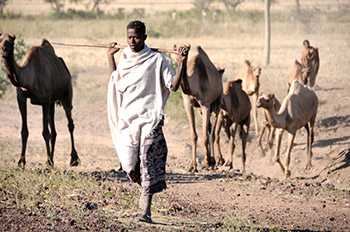Improving National Surveillance and Response Systems One Country at a Time
Public health surveillance has helped Ethiopia to detect outbreaks early, respond promptly and minimize the health, economic, social, and political impact of public health emergencies.
— Zewdu Assefa Edea, MPH-EFETP Resident, Ethiopian Public Health Institute
The 2014 Ebola outbreak in West Africa, the largest Ebola outbreak in history, taught us how easily a deadly disease can spread worldwide when effective surveillance and response systems are not in place to quickly detect and control infectious diseases from spreading. CDC and World Health Organization/Regional Office for Africa (WHO/AFRO) made it a priority to improve both systems.
What is IDSR?
IDSR promotes responsible allocation of resources at the community, health facility, district, and national levels by integrating and streamlining common surveillance activities: detection, reporting, analysis, interpretation, feedback, and action.
Integrated Disease Surveillance and Response (IDSR), a public health framework, helps nations improve their surveillance and response systems.
National disease surveillance and response systems are complex, making them tricky to evaluate.
After Ebola, CDC and WHO/AFRO worked to make IDSR easier to understand and use, from the frontline health post to the top level of national public health. To evaluate public health system implementation, identify problems, and produce actionable recommendations, CDC and WHO/AFRO developed an IDSR assessment tool to address the five key points listed below:
- List of priority diseases, conditions, and events,
- Standard or uniform case definitions for identifying priority diseases, conditions, and events,
- Critical denominators to analyze reported diseases, conditions, and events,
- Alert thresholds to trigger action for suspected outbreaks of epidemic-prone diseases, conditions, and events, and
- Quality of country’s epidemiologic or public health bulletin.
Taking Ownership in Ethiopia

Working with CDC, WHO, United States Agency for International Development (USAID), and the Western Michigan Evaluation Center, and WHO, Ethiopia’s Public Health Institute (EPHI) took the lead to assess their IDSR capacity and implementation. In May of 2016, a team of national and international disease detection experts used the tool to evaluate 13 sites across the country to do the following: (1) document key elements of disease surveillance in Ethiopia, and (2) provide up-to-date, actionable information to make improvements.
Putting Results to Action
The assessment pinpointed specific areas to improve within the Ethiopian surveillance and response system and sparked quick action by public health officials. Since then, EPHI has been applying the recommendations, including upgrading data collection and feedback systems, expanding surveillance, and improving communications. EPHI is now offering health workers training in data management, public health emergency management, and rapid response. Revisions will serve as the baseline for further improvements in Ethiopia’s surveillance and response to health threats.

EPHI plans to expand the assessment to all regions in Ethiopia.
Next Steps
Ethiopia’s successful pilot of the new IDSR assessment tool can be a guide for other countries to increase their ability to prevent, detect, and respond to health threats.
With WHO/AFRO’s advocacy, the IDSR team within CDC’s Division of Global Health Protection hopes to duplicate this effort in other Global Health Security Agenda (GHSA) countries to strengthen health protection efforts across the globe.
Related Links
- Page last reviewed: December 12, 2016
- Page last updated: December 12, 2016
- Content source:


 ShareCompartir
ShareCompartir